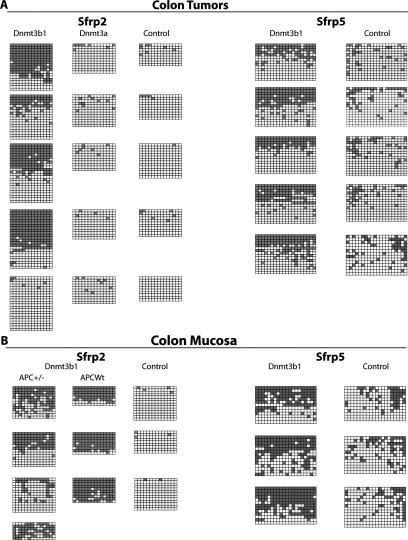Figure 6.
Dnmt3b1 causes hypermethylation of Sfrp2 and Sfrp5 in both tumors and normal colon epithelial cells. (A) Bisulfite sequencing analysis of the Sfrp2 and Sfrp5 promoter region of tumor DNA derived from control mice, Dnmt3b1-expressing mice, and Dnmt3a1-expressing mice (Sfrp2). In each case, five colon tumors from five different mice were analyzed. In the case of Sfrp2, 14 CpG sites were analyzed, and in the case of Sfrp5, 20 CpG sites were analyzed. Four out of five Dnmt3b1-expressing tumors showed clearly increased methylation at the Sfrp2 promoter, and all five such tumors showed increased methylation at the Sfrp5 promoter, when compared with control tumors. No significant methylation of Sfrp2 was detected in tumors derived from Dnmt3a1-overexpressing mice. (B) Bisulfite sequencing analysis of the Sfrp2 and Sfrp5 promoter region of DNA derived from non-tumor-bearing colon epithelial cells (colon mucosa). Sfrp2 methylation was analyzed in four Apc heterozygote mice (+/−) and in three Apc wild-type mice with Dnmt3b1 overexpression. Both Apc wild-type mice and Apc heterozygote mice show a clear increase in Sfrp2 methylation following Dnmt3b1 expression when compared with controls, suggesting that Dnmt3b1 directly methylates this target in the absence of coexisting pathology. (Bottom right) Methylation of Sfrp5 is also increased in colon epithelial cells from Dnmt3b1-expressing mice when compared with controls.

